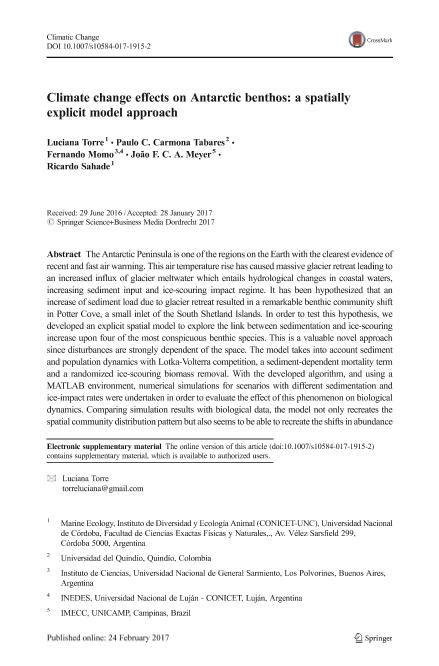Mostrar el registro sencillo del ítem
dc.contributor.author
Torre, Luciana

dc.contributor.author
Carmona Tabares, Paulo
dc.contributor.author
Momo, Fernando Roberto

dc.contributor.author
Meyer, Joã F. C. A.
dc.contributor.author
Sahade, Ricardo Jose

dc.date.available
2018-08-24T14:00:44Z
dc.date.issued
2017-04
dc.identifier.citation
Torre, Luciana; Carmona Tabares, Paulo; Momo, Fernando Roberto; Meyer, Joã F. C. A.; Sahade, Ricardo Jose; Climate change effects on Antarctic benthos: a spatially explicit model approach; Springer; Climatic Change; 141; 4; 4-2017; 733-746
dc.identifier.issn
0165-0009
dc.identifier.uri
http://hdl.handle.net/11336/56934
dc.description.abstract
The Antarctic Peninsula is one of the regions on the Earth with the clearest evidence of recent and fast air warming. This air temperature rise has caused massive glacier retreat leading to an increased influx of glacier meltwater which entails hydrological changes in coastal waters, increasing sediment input and ice-scouring impact regime. It has been hypothesized that an increase of sediment load due to glacier retreat resulted in a remarkable benthic community shift in Potter Cove, a small inlet of the South Shetland Islands. In order to test this hypothesis, we developed an explicit spatial model to explore the link between sedimentation and ice-scouring increase upon four of the most conspicuous benthic species. This is a valuable novel approach since disturbances are strongly dependent of the space. The model takes into account sediment and population dynamics with Lotka-Volterra competition, a sediment-dependent mortality term and a randomized ice-scouring biomass removal. With the developed algorithm, and using a MATLAB environment, numerical simulations for scenarios with different sedimentation and ice-impact rates were undertaken in order to evaluate the effect of this phenomenon on biological dynamics. Comparing simulation results with biological data, the model not only recreates the spatial community distribution pattern but also seems to be able to recreate the shifts in abundance under sedimentation enhancement, pointing out its importance as a structuring factor of polar benthic communities. Considering the challenges of Antarctic field work, this model represents a powerful tool for assessing, understanding, and predicting the effects of climate change on threatened Antarctic coastal ecosystems.
dc.format
application/pdf
dc.language.iso
eng
dc.publisher
Springer

dc.rights
info:eu-repo/semantics/openAccess
dc.rights.uri
https://creativecommons.org/licenses/by-nc-sa/2.5/ar/
dc.subject
Benthos
dc.subject
Global Warming
dc.subject
Model
dc.subject
Sediments
dc.subject.classification
Otras Ciencias Biológicas

dc.subject.classification
Ciencias Biológicas

dc.subject.classification
CIENCIAS NATURALES Y EXACTAS

dc.title
Climate change effects on Antarctic benthos: a spatially explicit model approach
dc.type
info:eu-repo/semantics/article
dc.type
info:ar-repo/semantics/artículo
dc.type
info:eu-repo/semantics/publishedVersion
dc.date.updated
2018-08-17T14:31:03Z
dc.identifier.eissn
1573-1480
dc.journal.volume
141
dc.journal.number
4
dc.journal.pagination
733-746
dc.journal.pais
Alemania

dc.journal.ciudad
Berlín
dc.description.fil
Fil: Torre, Luciana. Consejo Nacional de Investigaciones Científicas y Técnicas. Centro Científico Tecnológico Conicet - Córdoba. Instituto de Diversidad y Ecología Animal. Universidad Nacional de Córdoba. Facultad de Ciencias Exactas Físicas y Naturales. Instituto de Diversidad y Ecología Animal; Argentina
dc.description.fil
Fil: Carmona Tabares, Paulo. Universidad del Quindio; Colombia
dc.description.fil
Fil: Momo, Fernando Roberto. Universidad Nacional de Luján. Instituto de Ecología y Desarrollo Sustentable. Consejo Nacional de Investigaciones Científicas y Técnicas. Oficina de Coordinación Administrativa Parque Centenario. Instituto de Ecología y Desarrollo Sustentable; Argentina. Universidad Nacional de General Sarmiento. Instituto de Ciencias; Argentina
dc.description.fil
Fil: Meyer, Joã F. C. A.. Universidade Estadual de Campinas; Brasil
dc.description.fil
Fil: Sahade, Ricardo Jose. Consejo Nacional de Investigaciones Científicas y Técnicas. Centro Científico Tecnológico Conicet - Córdoba. Instituto de Diversidad y Ecología Animal. Universidad Nacional de Córdoba. Facultad de Ciencias Exactas Físicas y Naturales. Instituto de Diversidad y Ecología Animal; Argentina
dc.journal.title
Climatic Change

dc.relation.alternativeid
info:eu-repo/semantics/altIdentifier/url/http://link.springer.com/article/10.1007/s10584-017-1915-2
dc.relation.alternativeid
info:eu-repo/semantics/altIdentifier/doi/https://doi.org/10.1007/s10584-017-1915-2
Archivos asociados
